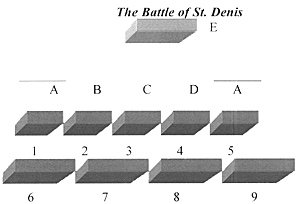Send in the Clowns Part I: The Battle of Dreux

The Peace of Amboise between the French Catholics and Huguenots lasted for an imperfect 4 years. Catherine de Medici played the Catholic Parties of Guise (now led by the Cardinal of Lorraine) and Constable Montmorency against each other, while planning the betrayal of the Huguenots with Spain’s Duke of Alva at Bayonne. This triggered a Huguenot reaction, when they rose on Michaelmas Day 1567. Conde and Coligny raised 500 Huguenots and endeavored to surprise the Royal family at Meaux and take control of the person of the King, Charles IX.
Catherine de Medici, who had already planned to crush the Huguenots without the niceties of a declaration, was surrounded at Meaux by 5,000 newly arrived Swiss mercenaries. The Swiss escorted her and her royal children to Paris, where a Royalist army was forming. On October 2, Conde established his ‘army’ headquarters at St. Denis.
With far fewer troops than the Catholics, Conde—who despised Montmorency—dispersed his tiny command so as to surround Paris. On November 10, Montmorency marched out of Paris to offer battle. The Huguenots under Conde had only 2,000—3,500 troops (depended upon whom you choose to believe). Montmorency’s Catholic army had over 5 times the number of men.
With a lack of judgment verging upon lunacy, Conde decided to fight. Montmorency, who marched upon his enemy in the early morning, took until late afternoon before he was ready to join battle—they having given Conde ample opportunity to escape destruction. Montmorency should have pressed Conde sooner, and Conde should have withdrawn to pick up the scattered detachments of his forces around Paris. The Clowns were ready for battle.
Coligny left all of his pike and some arquebusiers—1,000 men—(E) back at the village of St. Denis, and out of the battle. On both flanks he positioned a force of some 400 arquebusiers in trenches (A) to cover his flanks. Coligny (B) on the right, Conde (C) in the center, and Genlis (D) on the left commanded the three bodies of Huguenot horse, spread thin in a single line to try to cover the front of the enormous Catholic army.
The Constable Montmorency organized his army in two deep lines of units. On his left were the cavalry of Longueville and Sansac (1) supported by the Paris Militia (6). Left of center was the Constable Montmorency with his own heavy cavalry (2) supported by the massive Swiss pike block of 5,000 men (7 & 8). In the center of the front ranks rode the Marshal Montmorency, the Constable’s eldest son, with the gendarmerie (heavy cavalry) (3). To the right of center rode Marshal Cosse (4) with Biron’s cavalry (5) flanking him. The Duke of Montpensier’s infantry (9) supported them.
Having spent the entire day deploying in the face of the Huguenots without having reconnoitered their position, Montmorency moved his flanking cavalry into the ambushes of arquebusiers lying in their trenches. Both forces of Huguenot infantry achieved surprise, delivering a volley of lead at 50 yards, and thus disordering the Catholic cavalry.
Coligny and Genlis on the Huguenot flanks charged immediately, driving back the Catholic cavalry. Coligny succeeded in pushing the cavalry into and through the Paris Militia, which took to its heels. Conde, commanding the Huguenot cavalry with sword drawn—hardly the place for a commander-in-chief—charged the Catholic center, where the Catholic commander-in-chief, Constable Montmorency, was likewise leading the Catholic horse. The Huguenots triumphed again, and the unhorsed elderly Constable (74) was mortally wounded after refusing to surrender.
While the Huguenot cavalry could everywhere put the Catholics to route, they could not overcome the many thousands of Catholic infantry pike-armed infantry, and the reserves. Hence, Conde was forced back to St. Denis. This Catholics, their cavalry shattered and their dying leader, withdrew into Paris.
Conde waited at St. Denis for a few days, collected his outlying detachments, and headed for Germany to pick up a large force of German Lutheran reiters (heavy cavalry) and landsknechts (pike-armed infantry).
Inside Paris, Catherine de Medici took advantage of the death of the Constable by appointing her 17-year old son as ‘Lieutenant-General of the Kingdom.’ When Conde returned with a large army of French and Germans, ready to do battle on equal terms, Catherine lured them with false promises into signing another scrap of paper at the Peace of Langjumeau on March 23, 1568. From Paris she watched as the Huguenot gentlemen dispersed to their homes and their German co-religionists marched back to the Rhine. Indeed, she even advanced 300,000 gold ecus to help pay off the German mercenaries in the ranks.
Back to Novag's Gamer's Closet Summer 2003 Table of Contents
Back to Novag's Gamer's Closet List of Issues
Back to MagWeb Master Magazine List
© Copyright 2003 by Novag
This article appears in MagWeb.com (Magazine Web) on the Internet World Wide Web. Other articles from military history and related magazines are available at http://www.magweb.com